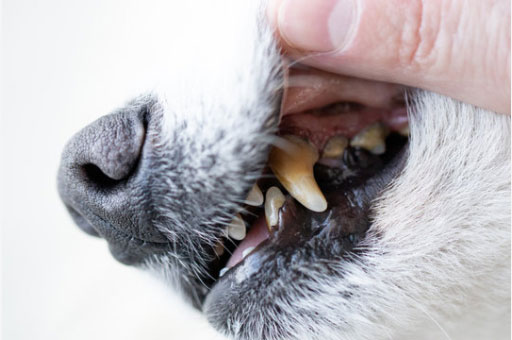Most dogs experience some or the other form of dental problems in their lifetime. Dental issues not only cause pain, but also cause serious infections, which can gradually spread to other organs such as heart, lungs or kidneys. It is important for the pet owners to maintain oral hygiene of their dog, to ensure its overall health. To avoid dental problems from showing up or getting worse, you need to know about what are the signs of bad teeth in dogs and how to deal with them.
In this article, we discuss about signs of bad teeth in dogs. Read on to learn more about it.
Signs of bad teeth
Change in teeth color
Healthy teeth always appear white, even in dogs. If you notice any yellowing or brownish teeth, it is a sign of bad teeth. Discoloring occurs due to the accumulation of plaque. This needs to be cleaned by the vet to avoid tooth decay. You may also need to clean your dog’s teeth with a special brush to keep them plaque and tartar free. Find tips for cleaning dog’s teeth here.

Bad breath
Dog’s breath may not always smell good because of its eating habits, but if you find it bad when it has not eaten any garbage, then it is an indication of a dental problem. The buildup of plaque, leading to the development of bacteria in the mouth results in bad breath. If it smells really foul, then it is an indication of gum disease. Gum disease needs to be addressed immediately, otherwise, it can spread and harm other organs.
Scratching their mouth
If your dog is constantly scratching at the mouth with its paws, it means something related to the mouth is bothering him. The dog might be in pain because of an abscess or gum disease. If you find him frequently rubbing against its mouth, you may first check for any particles stuck in teeth. If there’s nothing, then you should consult a vet to evaluate any dental problem.
Difficulty in eating
If you observe a change in the regular eating habits of your dog, such as chewing slowly or refusing to eat his favourite food, then he maybe suffering from a dental issue. He may be in great discomfort for not being able to eat. However, some dogs have their regular meals even when they have dental diseases. This makes it hard to understand the situation. You may be able to tell by the way they bite, chew and eat their food.
Red and swollen gums
Redness and swelling of gums often indicates gum disease or other infection. This can be very painful for the dog and needs to be treated. The vet may cleanup the plaque and bacterial formation. If there’s any tooth abscess, it may need to be pulled out.
Drooling
Drooling is a very common dog’s thing, but sometimes it can be a sign of an underlying teeth problem. Your dog may start to drool excessively, if it is pain, because of a tooth abscess or infection. Your pet may have been hurt and the discomfort may make it difficult to close his mouth and cause drooling.





